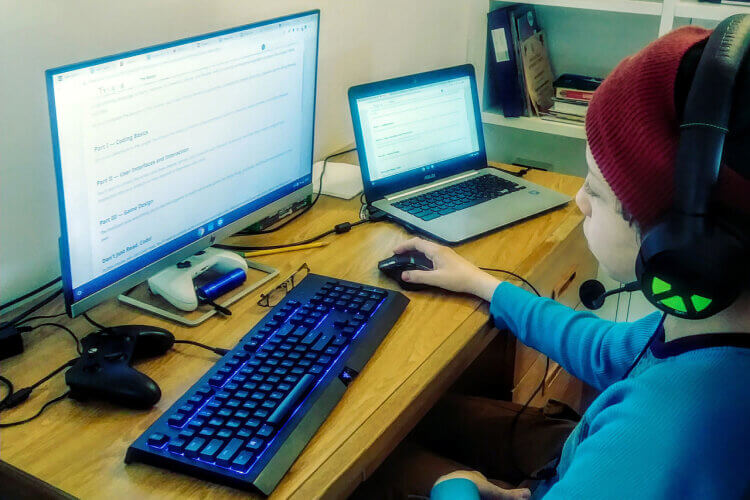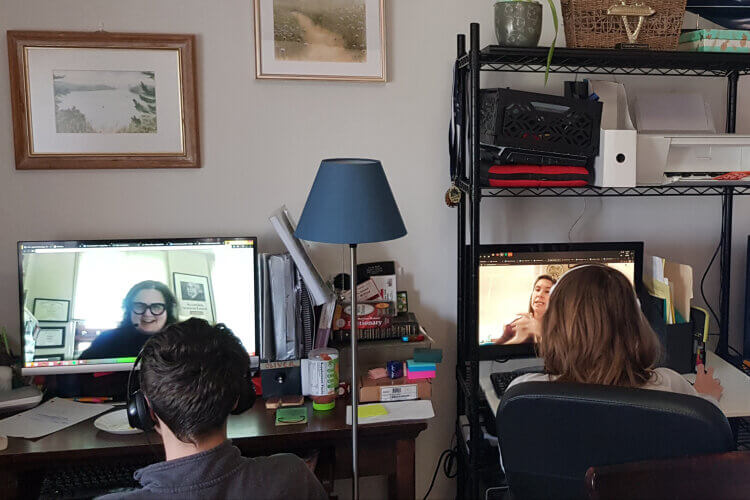The COVID-19 pandemic forced instructors to move classes designed for face-to-face delivery to remote delivery almost overnight. The shift resulted in challenges faced by students and instructors. Remote learning required students to approach their education using learning strategies differently, and during this transition, many students faced difficulties with a multitude of financial, emotional, and psychological issues related to the pandemic. In addition to being tested to adapt the delivery of content rapidly, teachers were also challenged to create and foster community in a remote learning scenario. In short, navigating this situation was complicated.

The reality of the upcoming school year remains in question for some schools. We do not yet know how COVID-19 will change how we live and learn, but it is anticipated we will experience a new normal, one in which online course delivery is likely to play an increasing role. A frequent conversation had this past spring amongst faculty at my institution centered around the topic of how to create community in online courses. A sense of community is critically important to creating a safe and productive learning space and improving retention. Nevertheless, knowing the value of community and understanding how to create and foster it are two different things.

This article shares the four elements of the Theory of Sense of Community (TSOC) (McMillan & Chavis, 1986), identifies how virtual fitness programming utilizes the four elements of the TSOC to establish and facilitate community within the online fitness environment and provides examples of strategies teachers can use to create and enhance a sense of community within online courses.
Theory of Sense of Community
The Theory of Sense of Community (SOC) utilizes four components to describe effective community: Membership, Influence, Reinforcement, and Shared Emotional Connection (McMillan & Chavis, 1986). Membership is “…the feeling of belonging or of sharing a sense of personal relatedness” (McMillan & Chavis, 1986, p. 9). The second element, Influence, is defined as “…a sense of mattering, of making a difference to a group and of the group mattering to its members” (McMillan & Chavis, 1986, p. 9). The third element, Reinforcement, is defined as “…integration and fulfillment of needs. This is the feeling that members’ needs will be met by the resources received through their membership in the group” (McMillan & Chavis, 1986, p. 9). Lastly, the fourth component, Shared Emotional Connection, is defined as “…the commitment and belief that members have shared and will share history, common places, time together, and similar experiences” (McMillan & Chavis, 1986, p. 9).

Virtual Fitness Programs and Community
Social distancing requirements this past spring forced many gyms and fitness facilities to close. In response, many people turned to virtual fitness opportunities, including walks, runs, and other fitness programming, to continue to work towards their health and fitness goals. No longer able to establish and facilitate community building through partner and/or group fitness activities common in face-to-face gym settings, the use of community building strategies in virtual programming became increasingly important.
Virtual fitness programs build community through the intentional use of the four elements that compose the TSOC. Membership is established utilizing a variety of technological tools. For example, participants in the Daily Burn, a multi-platform fitness program, can establish membership by connecting with other members through the app and/or social media platforms. Similarly, participants in Kayla Itsines’ Bikini Body Guide (BBG) program can join subcommunities with others with whom they identify, like #BBG moms, a sub-group for women with children, or #BBGover30, a sub-group for participants ages 30 and over, and within social media platforms. In comparison, people utilizing MyFitnessPal, an app that tracks goals, calories, and physical activity level, can join forums and groups where they can share personal success stories or find other participants to help with accountability (Feig, n.d.).

The Title IX Mermaid Series, a series of runs and triathlons organized by the women’s clothing company Title Nine, facilitates the development of Influence by creating opportunities for participants to join teams with other “Mermaids” to complete large fitness goals (i.e., run, walk, and/or bike 200 miles in 100 days). Team members enter their individual daily mile contributions and submissions are added together in real-time allowing members to measure their combined progress towards goal attainment. Additionally, participants may utilize social media platforms to celebrate the progress and success of their personal efforts and the contributions of others (“T9 Mermaid Race Series”, n.d.). The Daily Burn creates Reinforcement through the utilization of real-time, in-show chats with trainers. In comparison, MyFitnessPal utilizes forums for participants to ask questions about fitness, health, and wellness (Feig, n.d.). Finally, the fourth element, Shared Emotional Connection, can be created and facilitated through the use of apps and engagement through social media platforms with fitness coaches and other program participants (Feig, n.d.).

Strategies to Create Community in Online Courses
Teachers can introduce the same concepts of Membership, Influence, Reinforcement, and Shared Emotional Connection (McMillan & Chavis, 1986) into their online course delivery. For example, Membership in an online course can be established through the use of activities that encourage student interaction and engagement with one another and with the faculty member. Examples include, but are not limited to, student and instructor-generated discussion board posts, podcasts, and or video posts that allow opportunities to provide an understanding of the course material and share how personal experience informs the learning process. Discussion boards are a traditional means by which class members can interact. While they can be useful, students and faculty could also choose to share their thoughts, experiences, and perspectives using podcasts or short video posts. These strategies will allow for increased creativity and for students and faculty to share their voice in different formats. In addition to opportunities to meet one another and discuss course material, also consider integrating cooperative learning strategies for students to work one-on-one or in small groups to explore course content.

One strategy to create a sense of mattering, or Influence, could be asking students to create a list of course rules that identify expected and acceptable communication etiquette when discussing course material. A second example is establishing clear expectations for the amount and timeliness of the student and faculty interactions. In order for students to feel valued, respected, and heard, it is essential that a learning space is created, which encourages positive and productive interaction. Additionally, creating opportunities to recognize good work is essential. Consider asking students who achieve high scores on assignments if their work may be used as an exemplar with future classes. In addition to providing future students with examples of good work to help them understand and meet expectations, it further recognizes high performing students and shows the value for their effort.

In higher education, students choose to take classes for a variety of reasons. Some because it is a degree requirement, others because it is an area of interest or passion, some because it helps them reach the credit threshold for financial aid, and for others, it may be a combination of those three. Different rationale is likely to result in different expected outcomes. Given that, Reinforcement is likely to differ by student. As discussed above, all students want to feel welcome, valued, and supported. In general, a well-organized class is considered satisfactory. A comprehensive course outline that includes a calendar of expected topics, deadlines, and accompanying assignment and exam descriptions is essential. Additionally, consider sharing the amount of time students can anticipate it will take to receive a reply to questions. Students often come to our classes with differing levels of understanding of the course material. Consider creating an “Additional Readings” section. Post supplemental readings for students who need more information to prepare for success and for students who want to dive deeper into the content.

The final element, Shared Emotional Connection, is facilitated by delivering a safe, supportive, and engaging course with clear communication and transparent expectations. Consider utilizing assignments that allow students to collaborate. In higher education, students may be participating in different time zones. As such, consider assignments that do not require students to meet synchronously to have success. Utilize the different options available in your institution’s Learning Management System (LMS). Wiki’s are one example of a project to which students can individually contribute asynchronously to the assignment’s design and development. Additionally, consider utilizing free platforms that students can use, like free video editing software, to create and combine small group video projects.
Moving Forward
As you begin to prepare for the upcoming school year, consider how you can facilitate and enhance a sense of community using the four elements of the Theory of Sense of Community (TSOC): Membership, Influence, Reinforcement, and Shared Emotional Connection (McMillan & Chavis, 1986). Take stock of the teaching strategies you currently use. Does your course design facilitate community? Or, are there areas that could be enhanced? Virtual Fitness programming provides us with examples of how community can be created and maintained in online activities. Using the four elements outlined in the TSOC can help you build community in your online courses.
References
Feig, A. (n.d.). 6 awesome virtual fitness communities to help you stay on track. Fit Nation Magazine. Retrieved from https://fitnationmag.com/uncategorized/virtual-fitness-communities/
McMillan, D.W. & Chavis, D.M. (1986). Sense of community: A definition and theory. Journal of Community Psychology, 14, pp. 6-23.
T9 Mermaid Race Series. (n.d.). Title Nine Mermaid Series. Retrieved from https://www.mermaidseries.com/title-nine-mermaid-series
